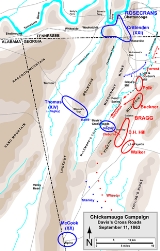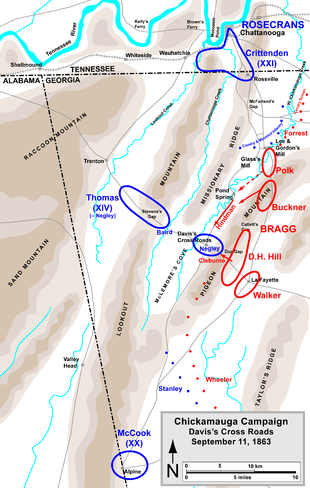
Battle of Davis' Cross Roads
Encyclopedia
The Battle of Davis's Cross Roads, also known as the Battle of Dug Gap, was fought September 10–11, 1863, in northwestern Georgia
Georgia (U.S. state)
Georgia is a state located in the southeastern United States. It was established in 1732, the last of the original Thirteen Colonies. The state is named after King George II of Great Britain. Georgia was the fourth state to ratify the United States Constitution, on January 2, 1788...
, as part of the Chickamauga Campaign
Chickamauga Campaign
The Chickamauga Campaign was a series of battles fought in northwestern Georgia from August 21 to September 20, 1863, between the Union Army of the Cumberland and Confederate Army of Tennessee.-Background:...
of the American Civil War
American Civil War
The American Civil War was a civil war fought in the United States of America. In response to the election of Abraham Lincoln as President of the United States, 11 southern slave states declared their secession from the United States and formed the Confederate States of America ; the other 25...
. It was more of a series of maneuvers and skirmishes than an actual battle and casualties were negligible.
Background
In the initial stages of the campaign, UnionUnion Army
The Union Army was the land force that fought for the Union during the American Civil War. It was also known as the Federal Army, the U.S. Army, the Northern Army and the National Army...
Maj. Gen.
Major general (United States)
In the United States Army, United States Marine Corps, and United States Air Force, major general is a two-star general-officer rank, with the pay grade of O-8. Major general ranks above brigadier general and below lieutenant general...
William S. Rosecrans's Army of the Cumberland
Army of the Cumberland
The Army of the Cumberland was one of the principal Union armies in the Western Theater during the American Civil War. It was originally known as the Army of the Ohio.-History:...
induced the Confederate
Confederate States Army
The Confederate States Army was the army of the Confederate States of America while the Confederacy existed during the American Civil War. On February 8, 1861, delegates from the seven Deep South states which had already declared their secession from the United States of America adopted the...
Army of Tennessee
Army of Tennessee
The Army of Tennessee was the principal Confederate army operating between the Appalachian Mountains and the Mississippi River during the American Civil War. It was formed in late 1862 and fought until the end of the war in 1865, participating in most of the significant battles in the Western Theater...
under Gen. Braxton Bragg
Braxton Bragg
Braxton Bragg was a career United States Army officer, and then a general in the Confederate States Army—a principal commander in the Western Theater of the American Civil War and later the military adviser to Confederate President Jefferson Davis.Bragg, a native of North Carolina, was...
to evacuate the city of Chattanooga, Tennessee
Chattanooga, Tennessee
Chattanooga is the fourth-largest city in the US state of Tennessee , with a population of 169,887. It is the seat of Hamilton County...
. Rosecrans dispatched three corps on three different roads toward northwestern Georgia. The corps on the center road was the XIV Corps under Maj. Gen. George H. Thomas, which moved just across the border to Trenton, Georgia
Trenton, Georgia
Trenton is a city in Dade County, Georgia, United States. The population was 1,942 at the 2000 census. It is the only incorporated municipality in the county, and as such it serves as the county seat....
, and prepared to move on to Lafayette in pursuit of Bragg. Lafayette was the present location of Bragg's army; due to misinformation and poor intelligence, Rosecrans was convinced that Bragg was demoralized and was retreating to Dalton, Georgia
Dalton, Georgia
Dalton is a city in Whitfield County, Georgia, United States. It is the county seat of Whitfield County and the principal city of the Dalton, Georgia Metropolitan Statistical Area, which encompasses all of both Murray and Whitfield counties. As of the 2010 census, the city had a population of 33,128...
, farther to the southeast. But once he realized that the Union forces had separated and were vulnerable, Bragg intended to attack Thomas, halt his advance, and defeat him.
Battle

James S. Negley
James Scott Negley was an American Civil War General, farmer, railroader, and U.S. Representative from the state of Pennsylvania. He played a key role in the Union victory at the Battle of Murfreesboro.-Early life:...
's division, supported by Brig. Gen. Absalom Baird
Absalom Baird
Absalom Baird was a career United States Army officer who distinguished himself as a Union Army general in the American Civil War. Baird received the Congressional Medal of Honor for his military actions-Early life:...
's division, was moving across the mouth of the cove on the Dug Gap road when Negley learned that Confederate units were concentrating around Dug Gap. Moving through determined resistance, he closed on the gap, withdrawing to Davis' Cross Roads in the evening of September 10 to await the supporting division.
Bragg had ordered Maj. Gen. Thomas C. Hindman
Thomas C. Hindman
Thomas Carmichael Hindman, Jr. was a lawyer, United States Representative from the 1st Congressional District of Arkansas, and a Major General in the Confederate States Army during the American Civil War....
with his division to assault Negley in the flank at Davis's Cross Roads, while Maj. Gen. Patrick Cleburne
Patrick Cleburne
Patrick Ronayne Cleburne was an Irish American soldier, best known for his service in the Confederate States Army during the American Civil War, where he rose to the rank of major general....
's division forced its way through Dug Gap to strike Negley in front. Hindman was to receive reinforcements for this movement, but most of them did not arrive. The Confederate officers, therefore, met and decided that they could not attack in their present condition. The next morning, however, fresh troops did arrive, and the Confederates began to move on the Union line. The supporting Union division had by now joined Negley, and, hearing of a Confederate attack, the Union forces determined that a strategic withdrawal to Stevens Gap was in order. Negley first moved his division to the ridge east of West Chickamauga Creek, where it established a defensive line. The other division then moved through them to Stevens Gap and established a defensive line there. Both divisions awaited the rest of Thomas's corps. All of this was accomplished under constant pursuit and fire from the Confederates.
Aftermath
After his abortive attempt to attack one isolated Union corps, Bragg turned his attention to the corps to his north, the XXI Corps under Maj. Gen. Thomas L. Crittenden, setting the stage for the bloody Battle of ChickamaugaBattle of Chickamauga
The Battle of Chickamauga, fought September 19–20, 1863, marked the end of a Union offensive in southeastern Tennessee and northwestern Georgia called the Chickamauga Campaign...
on September 19.

